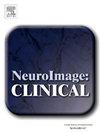动态脑状态的顺序模式区分帕金森病患者与轻度认知障碍
IF 3.6
2区 医学
Q2 NEUROIMAGING
引用次数: 0
摘要
帕金森病(PD)是一种神经退行性疾病,临床上表现为运动和认知功能的进行性损害。这些损伤背后的病理生理机制被认为是由于跨多个皮层和皮层下区域的功能性神经网络时空协调的破坏。本研究使用静息状态、功能磁共振成像(rs-fMRI)来确定动态功能网络连接(dFNC)状态的时间特征或顺序模式是否能准确区分认知正常的PD患者(PD- nc, n = 18)、轻度认知障碍的PD患者(PD- mci, n = 15)和老年健康对照(HC, n = 22)个体。结果表明,在rs-fMRI扫描期间,三种确定的dFNC状态(停留时间)所花费的时间比例在这三组之间有所不同。相对于PD-NC组(p = 0.0226)和HC组(p = 0.0027), PD-MCI组的个体在以低功能网络连通性为特征的dFNC状态下花费的时间明显更多,而相对于PD-NC组(p = 0.016)和HC组(p = 0.0562), PD-MCI组的个体在以反相关丘脑-皮层连通性为特征的状态下花费的时间往往更少。使用顺序模式挖掘的机器学习方法也被发现以中等精度在0.53到0.80之间区分组,揭示了dFNC状态的时间顺序中不同的顺序模式。这些发现强调了dFNC和序列模式挖掘作为进一步探索PD患者认知障碍病理生理基础的相关方法的潜力。本文章由计算机程序翻译,如有差异,请以英文原文为准。
Sequential patterning of dynamic brain states distinguish Parkinson’s disease patients with mild cognitive impairments
Parkinson’s disease (PD) is a neurodegenerative disease which presents clinically with progressive impairments in motoric and cognitive functioning. Pathophysiologic mechanisms underlying these impairments are believed to be attributable to a breakdown in the spatiotemporal coordination of functional neural networks across multiple cortical and subcortical regions. The current investigation used resting state, functional magnetic resonance imaging (rs-fMRI) to determine whether the temporal characteristics or sequential patterning of dynamic functional network connectivity (dFNC) states could accurately distinguish among people with PD who had normal cognition (PD-NC, n = 18), those with PD who had mild cognitive impairment (PD-MCI, n = 15), and older-aged healthy control (HC, n = 22) individuals. Results indicated that the proportion of time during the rs-fMRI scan that was spent in each of three identified dFNC states (dwell time) differed among these three groups. Individuals in the PD-MCI group spent significantly more time in a dFNC state characterized by low functional network connectivity, relative to participants in both the PD-NC (p = 0.0226) and HC (p = 0.0027) cohorts and tend to spend less time in a state characterized by anti-correlated thalamo-cortical connectivity, relative to both the PD-NC (p = 0.016) and HC (p = 0.0562) groups. A machine-learning method using sequential pattern mining was also found to distinguish among the groups with moderate accuracies ranging from 0.53 to 0.80, revealing distinct sequential patterns in the temporal ordering of dFNC states. These findings underscore the potential of dFNC and sequential pattern mining as relevant methods for further exploration of the pathophysiologic underpinnings of cognitive impairment among people living with PD.
求助全文
通过发布文献求助,成功后即可免费获取论文全文。
去求助
来源期刊

Neuroimage-Clinical
NEUROIMAGING-
CiteScore
7.50
自引率
4.80%
发文量
368
审稿时长
52 days
期刊介绍:
NeuroImage: Clinical, a journal of diseases, disorders and syndromes involving the Nervous System, provides a vehicle for communicating important advances in the study of abnormal structure-function relationships of the human nervous system based on imaging.
The focus of NeuroImage: Clinical is on defining changes to the brain associated with primary neurologic and psychiatric diseases and disorders of the nervous system as well as behavioral syndromes and developmental conditions. The main criterion for judging papers is the extent of scientific advancement in the understanding of the pathophysiologic mechanisms of diseases and disorders, in identification of functional models that link clinical signs and symptoms with brain function and in the creation of image based tools applicable to a broad range of clinical needs including diagnosis, monitoring and tracking of illness, predicting therapeutic response and development of new treatments. Papers dealing with structure and function in animal models will also be considered if they reveal mechanisms that can be readily translated to human conditions.
 求助内容:
求助内容: 应助结果提醒方式:
应助结果提醒方式:


